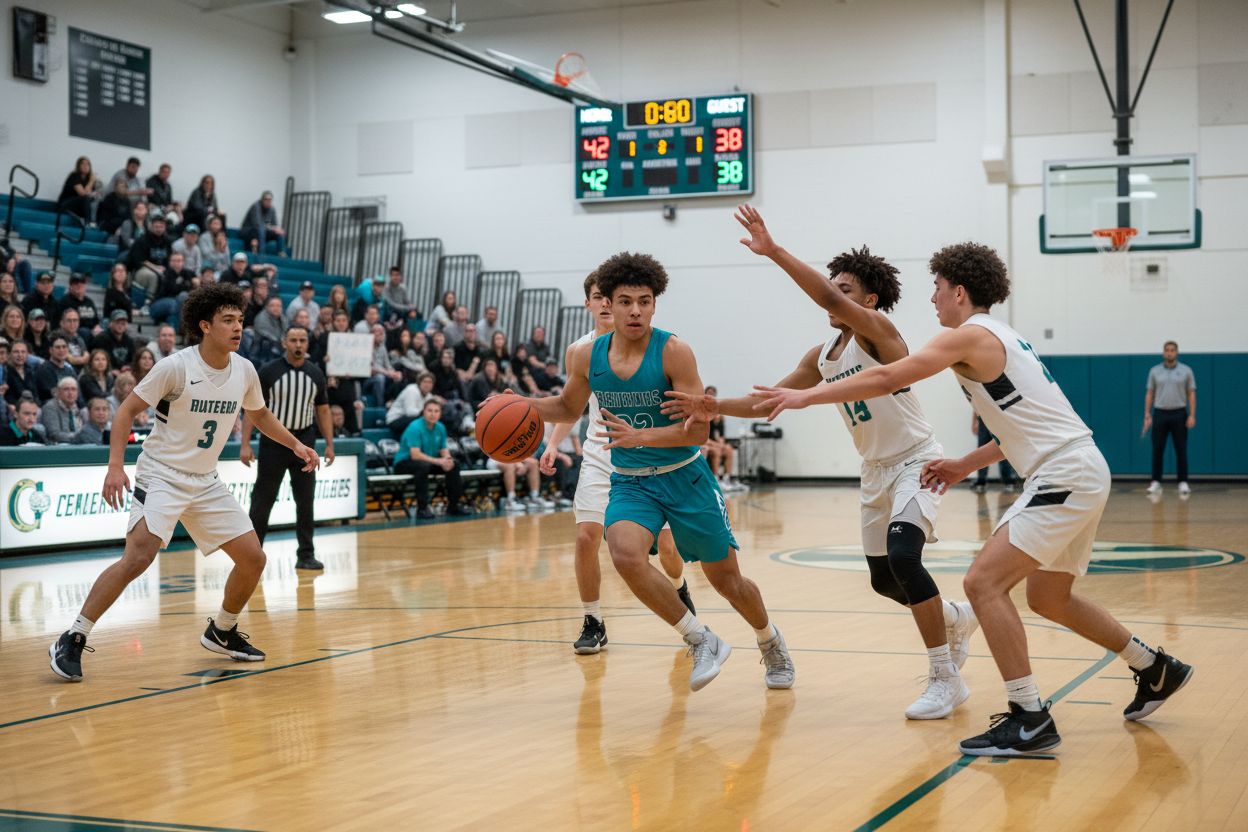Did you know that teams with proper court spacing can improve their field goal percentage by more than 10 percent? Basketball is a game of timing and precision, and even small mistakes in player positioning can cost points. Mastering spacing transforms simple plays into unstoppable offenses by creating open looks, clear driving lanes, and constant defensive headaches for opponents. Learning these concepts can give players and coaches a clear edge where it matters most.
Key Takeaways
| Point | Details |
|---|---|
| Importance of Spacing | Proper court spacing (12-15 feet) maximizes offensive opportunities by creating passing lanes and reducing defensive congestion. |
| Types of Spacing Configurations | Common formations like 3-out, 2-in and 5-out open post cater to different team strengths and enhance strategic offense. |
| Principles of Effective Movement | Maintain separation, read defenses, and create passing lanes to improve offensive flow and decision-making on the court. |
| Common Mistakes to Avoid | Players should watch for proximity failure, paint congestion, and static positioning to maintain effective spacing and offensive effectiveness. |
Table of Contents
- Definition And Core Concepts Of Spacing
- Types Of Spacing Used In Basketball
- Principles Of Effective Floor Movement
- Teaching And Implementing Spacing
- Common Spacing Mistakes To Avoid
Definition and Core Concepts of Spacing
In basketball, court spacing is the strategic positioning of players to maximize offensive opportunities and create optimal shooting lanes. According to Learn to Coach Basketball, ideal spacing typically ranges from 12 to 15 feet between players, a critical measurement that determines offensive effectiveness.
Effective spacing serves multiple strategic purposes:
- Spreads defensive players across the court
- Creates passing and driving lanes
- Reduces defensive congestion
- Increases shot percentage opportunities
The fundamental goal of spacing is to stretch the defense horizontally and vertically. When offensive players position themselves intelligently, they force defenders to make challenging decisions. This psychological pressure can create momentary hesitations that skilled teams exploit for scoring opportunities.
Realistic spacing isn’t about rigid positioning but dynamic movement. Players must constantly read the court, understanding when to fill gaps, when to clear out, and how their positioning impacts team offensive flow. Great spacing transforms a predictable offense into an unpredictable, fluid system that keeps defenders constantly adjusting and reacting.

Types of Spacing Used in Basketball
Basketball spacing strategies typically revolve around specific player formations that strategically distribute athletes across the court. According to Coaches Clipboard, three primary spacing configurations dominate competitive play: 3-out, 2-in; 4-out, 1-in; and 5-out open post offenses. Each configuration offers unique strategic advantages depending on team composition and opponent defensive schemes.
Let’s break down these spacing types:
Here’s a comparison of the three main basketball spacing formations:
| Spacing Type | Post Players | Perimeter Players | Best For |
|---|---|---|---|
| 3-out, 2-in | 2 in the post | 3 on perimeter | Teams with strong bigs |
| 4-out, 1-in | 1 in the post | 4 on perimeter | Driving lanes Pick and roll teams |
| 5-out open post | None in the post | 5 on perimeter | Teams with shooters Maximum spacing |
- 3-out, 2-in Spacing
- Two players positioned in the post area
- Three perimeter players spread outside
- Ideal for teams with strong interior big men
- Enables direct inside-out offensive strategies
- 4-out, 1-in Spacing
- One player positioned in the post
- Four players spread around the perimeter
- Maximizes floor stretch and driving lanes
- Provides flexibility for pick and roll actions
- 5-out Open Post Spacing
- All five players positioned outside the paint
- Creates maximum floor spacing
- Forces defenders to cover entire court
- Best for teams with multiple skilled shooters
Choosing the right spacing strategy depends on team strengths, player skills, and tactical objectives. Learn more about off-ball movement strategies to complement these spacing configurations and create dynamic offensive systems.
Principles of Effective Floor Movement
Effective floor movement transcends simple positioning and requires a deep understanding of court awareness and strategic player dynamics. According to Basketball Fundamentals, the most common spacing mistakes stem from neglecting weak-side awareness and inadvertently crowding the ball handler.
Key principles for maintaining optimal floor movement include:
- Maintain Separation: Always keep sufficient distance from teammates
- Read Defensive Positioning: Continuously assess defensive alignments
- Create Passing Lanes: Provide clear paths for ball movement
- Stay Mobile: Be ready to shift and adapt quickly
Successful floor movement requires players to develop situational intelligence. This means understanding when to cut, when to stay, and how your movement impacts team offensive flow. Learn more about basketball footwork techniques that can enhance your spatial awareness and movement efficiency.
Coaches can reinforce these principles through specific training drills like 5-out motion and drive-and-kick exercises. These practices help players internalize spacing concepts, teaching them to think dynamically about court positioning. The ultimate goal is creating an offensive system where players move instinctively, creating opportunities through intelligent, coordinated movement.
Teaching and Implementing Spacing
Spacing instruction requires a multi-dimensional approach that combines theoretical understanding with practical, game-like training scenarios. According to Learn to Coach Basketball, coaches can effectively teach spacing by using numbered spots inside and outside the arc, and encouraging players to move dynamically when the ball moves.
Key spacing training drills include:
- 5-Out Motion Spacing Drill: Develops comprehensive court awareness
- Drive-and-Kick Spacing Game: Improves reaction and positioning skills
- Triangle Spacing Drill: Enhances understanding of triangular offensive concepts
- Read-and-React Shell Drill: Builds defensive and offensive spatial intelligence
According to Basketball Fundamentals, the most effective teaching method involves creating spacing-focused scrimmages with consequences. The ‘string’ concept is particularly powerful: imagine players connected by an invisible string that remains taut. When a teammate drives toward you, you must either flare out, cut back-door, or loop to maintain optimal spacing.
Explore our detailed guide on motion offense strategies to further develop your team’s understanding of dynamic court movement and spacing principles. Remember, great spacing is less about rigid positioning and more about creating a fluid, responsive offensive system.
Common Spacing Mistakes to Avoid
Effective basketball spacing requires precise awareness and intentional movement. According to Basketball Fundamentals, players frequently commit critical spacing errors that dramatically reduce offensive effectiveness.
Common spacing mistakes include:
- Proximity Failure: Hanging too close to the ball handler (ideal distance is 12-15 feet)
- Paint Congestion: Overcrowding the lane with multiple players
- Static Positioning: Remaining stationary instead of constant movement
- Weak Side Neglect: Ignoring off-ball positioning and opportunities
Critical to understanding spacing is recognizing that every movement has a purpose. Basketball Fundamentals emphasizes that players must learn to stretch the defense by positioning strategically and moving away from drives intelligently. This means when a teammate drives, other players should create space rather than collapse toward the ball.
Explore our comprehensive guide on off-ball movement strategies to develop a deeper understanding of how proper positioning can transform your team’s offensive capabilities. The key is developing an intuitive sense of court geography and maintaining constant, purposeful movement.
Transform Your Team’s Spacing With Coaching Tools That Work
Struggling to see your players crowd the paint or freeze in place when real opportunities open? Spacing is a challenge for every coach. You know that court awareness and proper player positioning are the difference between predictable play and a team that scores with confidence. But turning spacing concepts into consistent habits can feel impossible without the right structure and drills. The good news is you do not have to do this alone.

Start building unstoppable offensive flow today. Visit Hoop Mentality for ready-to-use resources like progressive practice plans and detailed strategy guides created by experienced coaches. Every tool is designed to help you run effective spacing drills, improve court movement, and develop smarter players now. Explore our solutions and see how you can master the art of spacing with clarity and confidence.
Frequently Asked Questions
What is spacing in basketball?
Spacing in basketball refers to the strategic positioning of players on the court to maximize offensive opportunities and create optimal shooting lanes, typically 12 to 15 feet apart.
What are the key types of spacing formations in basketball?
The three main spacing configurations are 3-out, 2-in; 4-out, 1-in; and 5-out open post. Each formation serves different strategic purposes based on team strengths and offensive style.
How does effective floor movement enhance spacing in basketball?
Effective floor movement requires maintaining separation, reading defensive alignments, creating passing lanes, and staying mobile. This helps players make informed decisions, improving offensive flow and spacing.
What common spacing mistakes should players avoid?
Common mistakes include staying too close to the ball handler, overcrowding the paint, remaining stationary, and neglecting weak-side positioning. These errors can hinder offensive effectiveness and limit scoring opportunities.

